
It is more faster and easier to pass the Microsoft AZ-104 exam by using Practical Microsoft Microsoft Azure Administrator questuins and answers. Immediate access to the Down to date AZ-104 Exam and find the same core area AZ-104 questions with professionally verified answers, then PASS your exam with a high score now.
Also have AZ-104 free dumps questions for you:
NEW QUESTION 1
You have an on-premises server that contains a folder named D:Folder1.
You need to copy the contents of D:Folder1 to the public container in an Azure Storage account named contoso data.
Which command should you run?
Answer: C
Explanation:
The azcopy copy command copies a directory (and all of the files in that directory) to a blob container. The result is a directory in the container by the same name.
Reference:
https://docs.microsoft.com/en-us/azure/storage/common/storage-use-azcopy-blobs https://docs.microsoft.com/en-us/azure/storage/common/storage-ref-azcopy-copy
NEW QUESTION 2
You have an Azure subscription that contains a virtual network named VNET1. VNET1 contains the subnets shown in the following table.
Each virtual machine uses a static IP address.
You need to create network security groups (NSGs) to meet following requirements:  Allow web requests from the internet to VM3, VM4, VM5, and VM6.
Allow web requests from the internet to VM3, VM4, VM5, and VM6. Allow all connections between VM1 and VM2.
Allow all connections between VM1 and VM2.  Allow Remote Desktop connections to VM1.
Allow Remote Desktop connections to VM1.  Prevent all other network traffic to VNET1.
Prevent all other network traffic to VNET1.
What is the minimum number of NSGs you should create?
Answer: A
Explanation:
Note: A network security group (NSG) contains a list of security rules that allow or deny network traffic to resources connected to Azure Virtual Networks (VNet). NSGs can be associated to subnets, individual VMs (classic), or individual network interfaces (NIC) attached to VMs (Resource Manager).
Each network security group also contains default security rules. References:
https://docs.microsoft.com/en-us/azure/virtual-network/security-overview#default-security-rules
NEW QUESTION 3
You create an Azure subscription that is associated to a basic Azure Active Directory (Azure AD) tenant. You need to receive an email notification when any user activates an administrative role.
What should you do?
Answer: A
Explanation:
When key events occur in Azure AD Privileged Identity Management (PIM), email notifications are sent. For example, PIM sends emails for the following events: When a privileged role activation is pending approval
When a privileged role activation is pending approval  When a privileged role activation request is completed
When a privileged role activation request is completed  When a privileged role is activated
When a privileged role is activated When a privileged role is assigned
When a privileged role is assigned  When Azure AD PIM is enabled
When Azure AD PIM is enabled
References:
https://docs.microsoft.com/en-us/azure/active-directory/privileged-identity-management/pim-email-notifications
NEW QUESTION 4
You have an Azure web app named App1. App1 has the deployment slots shown in the following table:
In webapp1-test, you test several changes to App1. You back up App1.
You swap webapp1-test for webapp1-prod and discover that App1 is experiencing performance issues. You need to revert to the previous version of App1 as quickly as possible.
What should you do?
Answer: B
Explanation:
When you swap deployment slots, Azure swaps the Virtual IP addresses of the source and destination slots, thereby swapping the URLs of the slots. We can easily revert the deployment by swapping back.
You can validate app changes in a staging deployment slot before swapping it with the production slot. Deploying an app to a slot first and swapping it into production makes sure that all instances of the slot are
warmed up before being swapped into production. This eliminates downtime when you deploy your app. The traffic redirection is seamless, and no requests are dropped because of swap operations. You can automate this entire workflow by configuring auto swap when pre-swap validation isn't needed.
After a swap, the slot with previously staged app now has the previous production app. If the changes swapped into the production slot aren't as you expect, you can perform the same swap immediately to get your "last known good site" back.
Reference:
https://docs.microsoft.com/en-us/azure/app-service/deploy-staging-slots
NEW QUESTION 5
You create an Azure VM named VM1 that runs Windows Server 2019. VM1 is configured as shown in the exhibit. (Click the Exhibit button.)
You need to enable Desired State Configuration for VM1. What should you do first?
Answer: B
Explanation:
Status is Stopped (Deallocated).
The DSC extension for Windows requires that the target virtual machine is able to communicate with Azure. The VM needs to be started.
References:
https://docs.microsoft.com/en-us/azure/virtual-machines/extensions/dsc-windows
NEW QUESTION 6
Your network contains an on-premises Active Directory domain named adatum.com. The domain contains an organizational unit (OU) named OU1. OU1 contains the objects shown in the following table.
You sync OU1 to Azure Active Directory (Azure AD) by using Azure AD Connect. You need to identify which objects are synced to Azure AD.
Which objects should you identify?
Answer: B
Explanation:
Reference:
https://docs.microsoft.com/en-us/azure/active-directory-domain-services/synchronization
NEW QUESTION 7
You plan to create the Azure web apps shown in the following table.
What is the minimum number of App Service plans you should create for the web apps?
Answer: D
NEW QUESTION 8
You have an on-premises network that you plan to connect to Azure by using a site-to-site VPN.
In Azure, you have an Azure virtual network named VNet1 that uses an address space of 10.0.0.0/16. VNet1 contains a subnet named Subnet1 that uses an address space of 10.0.0.0/24.
You need to create a site-to-site VPN to Azure.
Which four actions should you perform in sequence? To answer, move the appropriate actions from the list of actions to the answer area and arrange them in the correct order.
NOTE: More than one order of answer choices is correct. You will receive credit for any of the correct orders you select.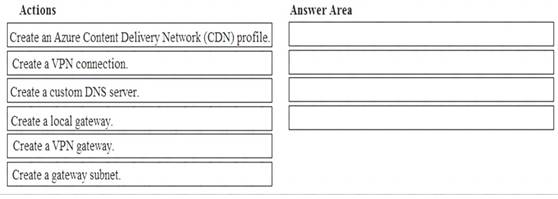

Answer: A
NEW QUESTION 9
You have an Azure subscription named Subscription1 that contains the resources shown in the following table.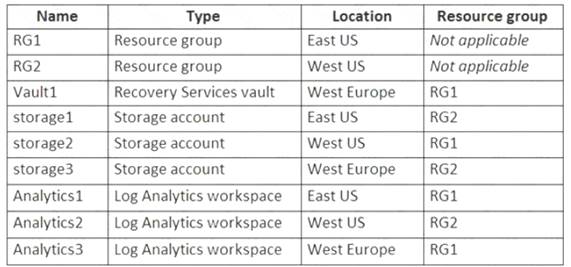
You plan to configure Azure Backup reports for Vault1.
You are configuring the Diagnostics settings for the AzureBackupReports log.
Which storage accounts and which Log Analytics workspaces can you use for the Azure Backup reports of Vault1? To answer, select the appropriate options in the answer area.
NOTE: Each correct selection is worth one point.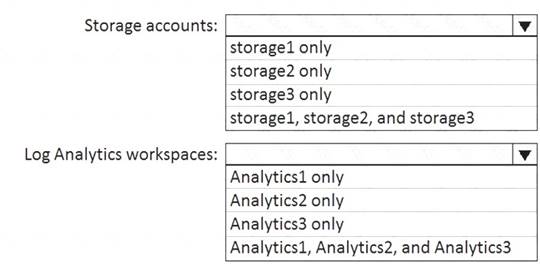
Answer: A
NEW QUESTION 10
This question is part of a series of questions that present the same scenario. Each question in the series contains a unique solution that might meet the stated goals. Some question sets might have more than one correct solution, while others might not have a correct solution.
After you answer a question in this section, you will NOT be able to return to it. As a result, these questions will not appear in the review screen.
You have an Azure subscription named Subscription1 that contains the resources shown in the following table.
VM1 connects to a virtual network named VNET2 by using a network interface named NIC1. You need to create a new network interface named NIC2 for VM1.
Solution: You create NIC2 in RG1 and Central US. Does this meet the goal?
Answer: B
Explanation:
The virtual machine you attach a network interface to and the virtual network you connect it to must exist in the same location, here West US, also referred to as a region.
References:
https://docs.microsoft.com/en-us/azure/virtual-network/virtual-network-network-interface
NEW QUESTION 11
You have an Azure subscription named Subscription1.
In Subscription1, you create an Azure web app named WebApp1. WebApp1 will access an external service that requires certificate authentication.
You plan to require the use of HTTPS to access WebApp1. You need to upload certificates to WebApp1.
In which formats should you upload the certificate? To answer, select the appropriate options in the answer area.
NOTE: Each correct selection is worth one point.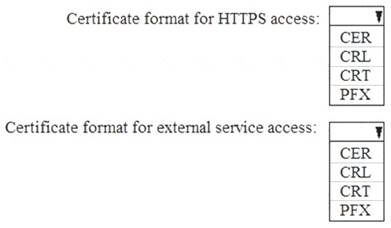
Answer: A
NEW QUESTION 12
You have an Azure subscription that contains an Azure Storage account storageaccount1.
You export storage account as an Azure Resource Manager template. The template contains the following sections.
For each of the following statements, select Yes if the statement is true. Otherwise, select No. NOTE: Each correct selection is worth one point.

Answer: A
NEW QUESTION 13
You need to recommend a solution for App1. The solution must meet the technical requirements. What should you include in the recommendation? To answer, select the appropriate options in the answer area.
NOTE: Each correct selection is worth one point.

 A SQL database
A SQL database A web front end
A web front end A processing middle tier
A processing middle tier Technical requirements include:
Technical requirements include: Move all the virtual machines for App1 to Azure.
Move all the virtual machines for App1 to Azure. Minimize the number of open ports between the App1 tiers.
Minimize the number of open ports between the App1 tiers.Answer: A
NEW QUESTION 14
Note: This question is part of a series of questions that present the same scenario. Each question in the series contains a unique solution that might meet the stated goals.
Some question sets might have more than one correct solution, while others might not have a correct solution.
After you answer a question in this section, you will NOT be able to return to these questions will not appear m the review screen.
You manage a virtual network named VNetl1 that is hosted in the West US Azure region. VNetl1 hosts two virtual machines named VM1 and VM2 that run Windows Server.
You need to inspect all the network traffic from VM1 to VM2 for a period of three hours. Solution: From Azure Network Watcher, you create a packet capture.
Does this meet the goal?
Answer: B
Explanation:
Azure Network Watcher provides tools to monitor, diagnose, view metrics, and enable or disable logs for resources in an Azure virtual network.
Capture packets to and from a VM
Advanced filtering options and fine-tuned controls, such as the ability to set time and size limitations, provide versatility. The capture can be stored in Azure Storage, on the VM's disk, or both. You can then analyze the capture file using several standard network capture analysis tools.
Network Watcher variable packet capture allows you to create packet capture sessions to track traffic to and from a virtual machine. Packet capture helps to diagnose network anomalies both reactively and proactivity.
References:
https://docs.microsoft.com/en-us/azure/network-watcher/network-watcher-monitoring-overview
NEW QUESTION 15
You have an Azure virtual machine named VM1 that runs Windows Server 2019. You sign in to VM1 as a user named User 1 and perform the following actions:
* Create files on drive C.
* Create files on drive D.
* Modify the screen saver timeout.
* Change the desktop background. You plan to redeploy VM1.
Which changes will be lost after you redeploy VM1?
Answer: C
Explanation:
As D drive is temporary storage so new files on D drive will be lost. The screensaver, wall paper, new files on C drive are available after Redeploy.
Reference:
https://docs.microsoft.com/en-us/azure/virtual-machines/troubleshooting/redeploy-to-new-node-windows
NEW QUESTION 16
You have a Recovery Service vault that you use to test backups. The test backups contain two protected virtual machines.
You need to delete the Recovery Services vault. What should you do first?
Answer: A
Explanation:
You can't delete a Recovery Services vault if it is registered to a server and holds backup data. If you try to delete a vault, but can't, the vault is still configured to receive backup data.
Remove vault dependencies and delete vault
In the vault dashboard menu, scroll down to the Protected Items section, and click Backup Items. In this menu, you can stop and delete Azure File Servers, SQL Servers in Azure VM, and Azure virtual machines.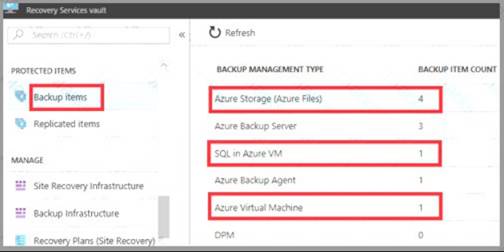
References: https://docs.microsoft.com/en-us/azure/backup/backup-azure-delete-vault
NEW QUESTION 17
Note: This question is part of a series of questions that present the same scenario. Each question in the series contains a unique solution that might meet the stated goals. Some question sets might have more than one correct solution, while others might not have a correct solution.
After you answer a question in this section, you will NOT be able to return to it. As a result, these questions will not appear in the review screen.
You have a computer named Computer1 that has a point-to-site VPN connection to an Azure virtual network named VNet1. The point-to-site connection uses a self-signed certificate.
From Azure, you download and install the VPN client configuration package on a computer named Computer2.
You need to ensure that you can establish a point-to-site VPN connection to VNet1 from Computer2. Solution: You modify the Azure Active Directory (Azure AD) authentication policies.
Does this meet this goal?
Answer: B
Explanation:
Instead export the client certificate from Computer1 and install the certificate on Computer2. Note:
Each client computer that connects to a VNet using Point-to-Site must have a client certificate installed. You generate a client certificate from the self-signed root certificate, and then export and install the client certificate. If the client certificate is not installed, authentication fails.
Reference:
https://docs.microsoft.com/en-us/azure/vpn-gateway/vpn-gateway-certificates-point-to-site
NEW QUESTION 18
Your company has three offices. The offices are located in Miami, Los Angeles, and New York. Each office contains a datacenter.
You have an Azure subscription that contains resources in the East US and West US Azure regions. Each region contains a virtual network. The virtual networks are peered.
You need to connect the datacenters to the subscription. The solution must minimize network latency between the datacenters.
What should you create?
Answer: A
Explanation:
Azure Virtual WAN is a networking service that brings many networking, security, and routing functionalities together to provide a single operational interface.
The Virtual WAN architecture is a hub and spoke architecture with scale and performance built in for branches (VPN/SD-WAN devices), users (Azure VPN/OpenVPN/IKEv2 clients), ExpressRoute circuits, and virtual networks.
Azure regions serve as hubs that you can choose to connect to. All hubs are connected in full mesh in a Standard Virtual WAN making it easy for the user to use the Microsoft backbone for any-to-any (any spoke) connectivity.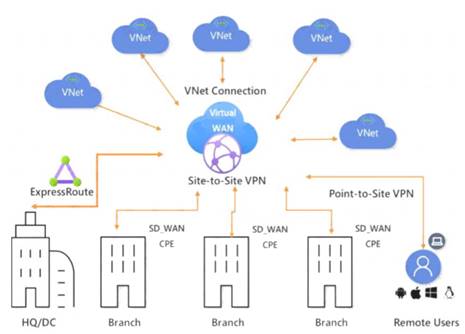
Virtual WAN offers the following advantages:
Integrated connectivity solutions in hub and spoke: Automate site-to-site configuration and connectivity between on-premises sites and an Azure hub.
Automated spoke setup and configuration: Connect your virtual networks and workloads to the Azure hub seamlessly.
Intuitive troubleshooting: You can see the end-to-end flow within Azure, and then use this information to take required actions.
Reference:
https://docs.microsoft.com/en-us/azure/virtual-wan/virtual-wan-about
NEW QUESTION 19
......
P.S. Easily pass AZ-104 Exam with 454 Q&As Allfreedumps.com Dumps & pdf Version, Welcome to Download the Newest Allfreedumps.com AZ-104 Dumps: https://www.allfreedumps.com/AZ-104-dumps.html (454 New Questions)